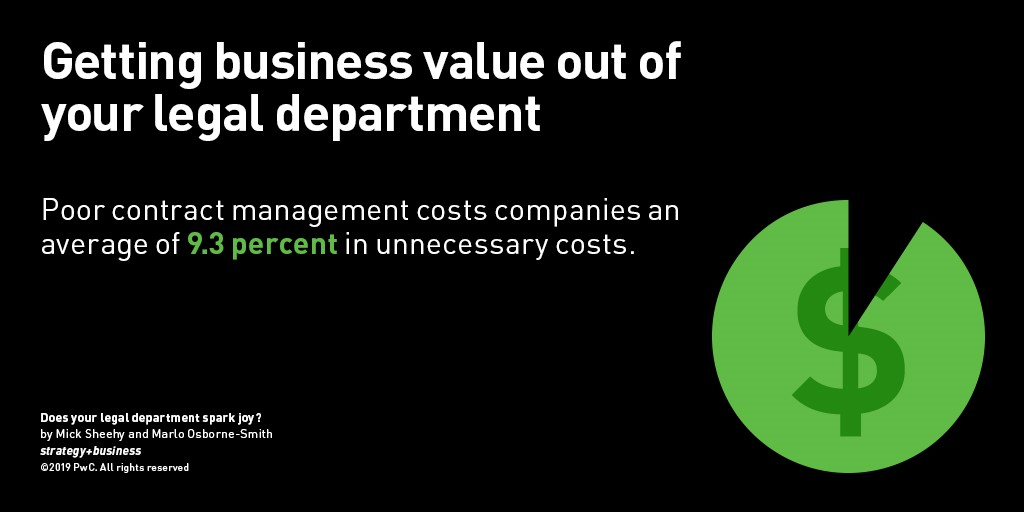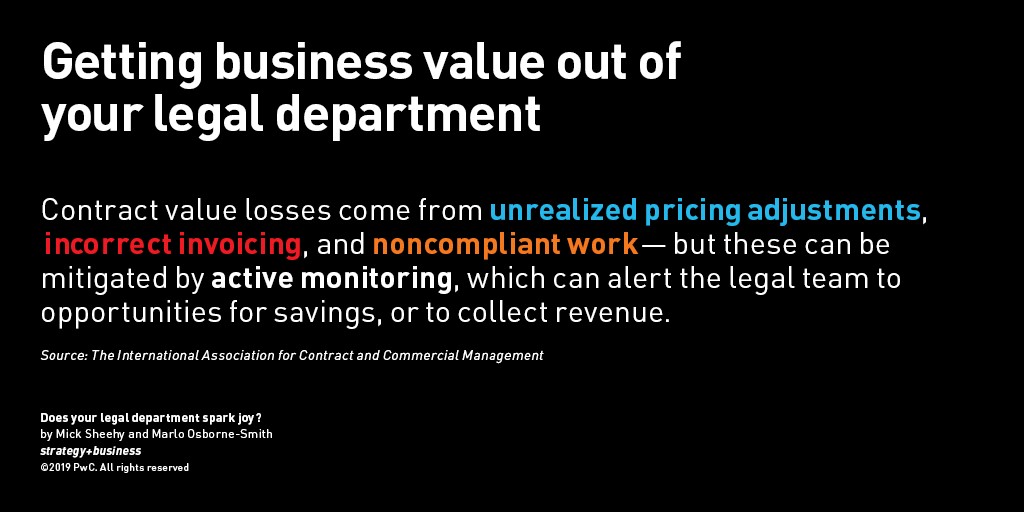Does your legal department spark joy?
How a contract management system can extract untapped value from your legal processes.
Marie Kondo would make a great lawyer. If ever there was a need for some tidying up, it’s with the documents flowing through a company’s legal department. What Kondo knows, and what every CFO should understand, is that the act of tidying isn’t superficial. When it involves digital management systems, it can lead to a transformation of cluttered and inaccessible information — allowing a company to focus its attention on the essential insights hidden in the documents.
Consider the following common scenarios: General counsel gets an email asking what the business’s rights are on a particular contract. A search of the filing cabinet and online repository produces nothing. The archive room holds some backdated copies of the contract, but not the first or the latest. The cloud server is a nightmare “backup” where no one can find anything.
Another day, the legal team is asked to draft a new contract for a standard service negotiated many times before, but there is no clear precedent or playbook and the portfolio of similar contracts reveals a large range of variances. The document must essentially be created from scratch — an inefficient process and, worse, one that introduces inconsistency, additional risk, and potential value loss.
Large corporations can have thousands of contracts built into their operations, and even small enterprises can be dealing with hundreds. Knowing where each agreement stands with regard to renegotiation, payments, and terms of renewal has long been a phenomenal feat, even in the age of digitization. But if the electronic system is not designed for the whole business, is not utilizing the latest in machine learning, or is not easily searchable, the company is missing out on added value — to say nothing of the value lost in archives that may still be awaiting digitization.
What CFOs and legal teams alike understand is that contracts are more than just agreements. Embedded within their pages is the history of relationships and activities that over time give an enterprise its value. These include agreements, decisions, and commitments to achieve goals. Everything in a business relates back to its contracts. But the most important aspects of these legal documents are inaccessible in most companies today. Either the contracts are hidden away in filing cabinets or they might as well be — because they’re trapped in digital systems that are almost as hard to search. Worse, the leverage that the legal department could bring to the business through contract management is generally unrecognized and untapped.
In a digitization project, old contracts can be scanned into a digital format, and supplemented with searchability, metadata tags, and structure. These contracts can then be read and administered with contract life-cycle management (CLM) software. CLM allows the legal department to diagnose past performance problems and understand the difference between what is happening in practice and what was agreed to in the contract. This insight can help predict additional outcomes and inform sophisticated negotiating strategies. For instance, if the company knows it never seeks liquidated damages under certain provisions of contracts, should it waste time trying to obtain these rights in the future?
Creating value
Historically, when companies wanted to identify deals trends to present to their clients, they deployed teams of junior lawyers to analyze contract databases, a project that could take months. Today, forward-thinking companies with a digital contract repository and basic analytics technology can do a similar exercise in just a few clicks.
Digitization and the active life-cycle management of contracts should now be relatively easy tasks to accomplish, not a leap into technology so sophisticated or cutting-edge that expert operators are required. Although many organizations have taken steps to move contracts from filing cabinets into cloud repositories, these actions have often been inconsistently implemented across the company, siloed within individual business units. The legal department, however, intersects with all parts of the business, and thus is in a unique position to oversee contract management.
In the life cycle of a typical contract under the old system, the legal team is involved only twice: at the start, in drafting, negotiating, and executing the document; and at the end, in renewal, termination, or management of a dispute. Yet the vast majority of a contract’s value exists in between, as the relationship governed by the contract evolves — an evolution in which the legal team typically plays no role. This should change. By overseeing contracts throughout the life cycle of a deal or relationship, the legal department can provide real-time data, monitor value leakage, reduce risk, and help reduce the barriers among business units. It thus shifts from being a reactively task-focused function to an integral source of value creation.


Strategically, this is where legal departments can reposition themselves in the corporate environment to great effect. Rather than being driven by the business’s legal needs, lawyers will be able to use the insights gleaned from managing the contract life cycle to actively aid in achieving organizational goals.
For example, if the legal team knows how many contracts are under management, they are well placed to advise on resourcing requirements (because they know when major transactions are coming up for renewal) or on whether contracts should be renegotiated and, if so, on what terms. Maybe the CFO would be interested to hear that the business has had the ability to increase prices three times in the last year, and that not doing so has cost the company a few hundred million dollars.
Once you recognize this, the digitization of contracts suddenly offers much more appeal than just cleaning out storage. The opportunities for in-house counsel to play a larger role are uncovered. Should there be an enterprise-wide view of contracts? The legal department would be well placed to take this on.
Understanding of and access to the data that is held in contracts offer multiple benefits. Lawyers, and their organizations, can provide value that would previously go unrealized. Decision making becomes easier because it is based on real data, not guesswork. Crisis management scenarios that stem from or affect legal matters can be addressed with less delay. All of these benefits become differentiators necessary to succeed in a digitally transforming, fast-moving world.
Managing the contract life cycle
Managing the life cycle of a contract with CLM software will help at all stages of contracting, from negotiation to execution, performance, and modification, through to termination or renewal; all these stages can occur with oversight from the legal department with timeliness and ease in a secure platform.
The ultimate advantage of such a system is that contracting becomes quicker and more efficient. Visibility and collaboration can be improved across departments — such as procurement, sales, and marketing — and contracts can be integrated with other systems, such as cloud sharing tools, sales databases, and customer relationship management (CRM) systems, which creates one source of truth for client data. Contracts can be standardized, version control enacted, workflows maintained, and tracking allowed so that key dates aren’t missed.
It also affords the legal department the opportunity to ensure business units are managing contract life cycles with the best interest of the entire company in mind. Although contract creation can, for simpler cases, be automated within CLM software — relieving the legal department of authoring all contracts and empowering the business with self-service tools — it can also be an aid in more complex drafting scenarios, ensuring important aspects aren’t missed while speed is maintained. Workflows will ensure that legal staff members are looped in only at the points they need to be, such as in review, approvals, or signing.
Preventing value leakage
The degree to which companies leak revenue or incur unnecessary costs in contracts varies greatly. The International Association for Contract and Commercial Management (IACCM) estimates that the average direct contract value leakage (pdf) for all companies is around 9.3 percent. Those that do contracts badly can have as much as a 40 percent loss.
For a company with an annual revenue of US$1 billion and 6.2 percent contract leakage (i.e., a top performer when it comes to contract management), the gross margin could drop from $200 million to $138 million. For an average company with the same revenue but a contract leakage of around 12.4 percent, the gross margin would drop to $76 million. That’s a lot of money simply draining away due to contract management inefficiency.
Leakage is typically due to issues of contract robustness. As the IACCM outlines, this loss comes directly from unrealized pricing adjustments, incorrect invoicing, and noncompliant work. Indirectly, missed renewals and poor customer experience also cause loss.
Through active monitoring, cost leakage on existing contracts can be identified and mitigated, leading to substantial savings. Contract management software can alert the legal team to opportunities for savings, or to collect revenue, by avoiding missed deadlines for payment or collection, overpayment, and penalties.
Legal departments are usually thought of as cost centers, so those that start proactively saving or even making money will be ones that impress the C-suite. Across a large portfolio of contracts, it takes only a very small percentage point improvement for the legal department to more than pay for itself.
Digital contracts can also be tracked for variations; if a negotiation goes off track on a standard contract, it is easy to identify where. Indeed, the entire history of contracts can be analyzed for common areas of deviation; future negotiations can then focus on these hot spots and position them accordingly.
Recent work we completed with a global technology firm showed the benefits of visibility quite clearly. The company had more than 900 clients and 40,000 contracts and legal documents. The absence of a central repository or control meant a lack of visibility into risks and opportunities. By creating a central pool for these contracts, and mobilizing the data lying within them, the company has become able to identify contract variations, exposures, and risks before they become problematic.
A changing regulatory environment
This is an issue not only of working smarter, but of working safer. The more contracts a company is dealing with, the more legal risk they are potentially exposed to. Knowing what and where risk lies is critical for due diligence, and a dashboard drawing from key contract data can easily enable this. With a digital system, the legal department can see how many contracts it has, what type of agreements there are, and which channels or segments they’re located in, and thus catalog the material risk and value each contract holds to build a risk profile for the business.
In the current climate, this function is particularly important. Worldwide, regulations are proliferating, the complexity of compliance is increasing, and the cost of noncompliance is becoming steeper. Legal teams are being asked to go back and redo contracts, changing terms and policies as laws change. For example, the decision to end the U.K.’s London Interbank Offered Rate (LIBOR), a benchmarked interest rate for interbank short-term international loans, has led to the need to amend vast numbers of financial, derivative, and debt-based contracts. In a recent assignment with a global investment bank, PwC was able to search the bank’s contracts for LIBOR references (and variances) using a contract technology system, and then identify where remediation was needed. This gave the bank reliable data so it could then prioritize its approach to repapering and renegotiating, and address the changes required by the retirement of LIBOR with documentation software.
The ability to search and change clauses by using a CLM system will become more essential as regulation increases in response to a changing digital landscape. As the saying goes, ignorance is no excuse, and neither will be the fact that your contracts haven’t been updated because they are inconsistently written, still being sorted out of drawers, or lost in an impermeable cloud.
Taking the risk of not thoroughly updating contracts is understandable, but dangerous, because there is little way of knowing what a company’s exposure is when provisions have changed and noncompliance becomes enforceable. A CLM program will empower the legal team to home in on risks and obligations, and enable their swift amendment when necessary.
What’s the holdup?
If enabling these opportunities via digitization can be easily managed with current technology — and if doing so can help companies grow, manage risk, reduce cost, and even increase revenue — why are so many businesses not embracing contract life-cycle management?
Partly, it is a cultural issue, and one that will come as no surprise to lawyers and C-suite executives alike. When it comes down to it, legal departments, and the risk-averse lawyers that they are made up of, often just don’t want to change. Like most other heavily specialized functions, legal departments exist in a mutually reinforcing universe. Their special status keeps them separate from the rest of the business, and being separate reinforces their special status.
In truth, though, legal departments haven’t really needed to change. Contracts have been around for thousands of years, and although their interpretation and execution have varied over time, the basic process remains the same. An agreement is offered and accepted; a promise is made. It is only in the sheer scale of what is being asked of contracts (and lawyers) in the current digital and multi-jurisdictional era that the usual way of maintaining them is beginning to falter.
But blame cannot be laid entirely with culture. There is a lack of technological skills in legal departments that has not been addressed by businesses. Asking that legal experts, who are highly educated in their own field, become technologically savvy as well is a hurdle. This lack of capability leads to a lack of confidence, and can set back efforts to change the way work is administered. Change management skills are in short supply, so even where a positive attitude toward a change program exists, the ability to enact it may not.
Of course, technical limitations can be overcome by recruiting the right help. This requires investment and a robust business case. But the proposition is complicated by legal departments not typically being included in the annual capital expenditure allocation process and therefore having little track record in justifying these types of investments.
Finally, both organizations and the legal teams within them may lack understanding of the cost-benefit calculation of digitization and life-cycle management. The prize outlined above is not well understood, and the cost and effort of digitizing legacy contracts or implementing management software is seen as an added burden on a cost center not thought to be core to the business. More needs to be done to illustrate the enterprise-wide benefits of such a program.
How to achieve joy
It may sound daunting to “go digital,” but in reality the nomenclature makes the process seem more seismic than it is. Beginning contract life-cycle management is uncomplicated. Companies that wish to digitize their legal department should focus on six steps.
1. Have the conversation. It is important to ensure that everyone is on the same page when it comes to contract digitization and management. Even though it could be seen primarily as a tidying-up exercise for the legal department alone, the consequences for the business as a whole should be considered in order to maximize the potential benefits.
A technologically enabled legal department is one that is quicker and more efficient and that has a much larger role in the business than has traditionally been the case.
For example, what role does your company want legal to play in the organization going forward? If you haven’t digitized your legal department, does it even make sense to do so? If you have only a handful of contracts, maybe it isn’t where you’ll get the most value for your technology dollars. If it does make sense, what will the new end state look like? Will you have a more streamlined contract process? Or insights that will deliver organizational value? How will the role of the legal department change — will its staff begin to work proactively, managing risk and value leakage across the business?
For businesses that have already digitized, this first conversation might instead be about where those contracts are and what is being done with them. Are they centrally located? Does someone have oversight of their life-cycle management? Is value being created, or is it leaking through business unit crossovers?
2. Map the road ahead. Having decided upon an end state for digitization and management, outline how to get there. If the implementation of a contract management system includes moving from paper contracts to digital ones, an extensive period may be needed to simply find the contracts in question.
It will be necessary to have a clear map and milestones to ensure the project doesn’t stall in the tough stages before the payoff of a digitized system is realized. It is also important to establish a baseline here in order to assess the success of the project later on. Think about what you are trying to achieve. Is it a savings in hours? Dollars retained from lesser contract leakage? Knowing where you are now will allow you to measure the impact of the technology once it has been implemented.
3. Decide who is going to run the change program. If the scope of the digitization is to be larger than scanning contracts into a digital archive, a senior staff member should be selected to run, deliver, and embed the change program. This is where we see a lot of organizations fall down: They assign the best lawyer or the busiest employee to do something that employee either isn’t suited to or doesn’t have the time for.
Legal departments are often lacking in change management experience, and it is therefore important to put someone who has such experience in place to steer the program. This may mean bringing in an external person.
4. Know where the technology fits. Technology will play an important part in the success of a digital contract system, so it should be given proper due diligence. Before scanning documents, give some thought to what structure and metadata will be output and what it will be used for once digitized. The kind of life-cycle management technology the scanned documents will sit in, or connect to, after digitization will need to speak directly to what the company and department wish to accomplish.
Which technology is right for your business will depend in part on whether you need an enterprise approach (for example, where contract management is one part of a larger legal services or customer system) or you just want to lift in-house counsel’s visibility over contract data (in which case a smaller CLM may make more sense). With forethought, systems can be selected that will integrate into existing IT infrastructure.
5. Bring in (or build) the skills and capability. Legal departments are not IT departments, and many legal teams struggle with their ability to implement technology. They rarely have a technology person on their leadership, let alone their team. Increasingly, however, there is room for overlap. There is no reason that a legal department could not have its own data or analytics people on staff, but lacking that expertise, it will be necessary to bring the skills in for the life of the project, and perhaps beyond.
Thought should go toward upskilling the legal team itself for the continued digitization of contracts, the management of their workflow, and the extraction of insights and value from the system once it is live. The technology will be only as good as the people using it; there is no point spending money on a new system in the absence of onboarding and training.
6. End steps. Once the new system is implemented, it is time to be courageous. The comfort of reverting to “the way things used to be done” will always be a temptation. Technology and processes that enable the old ways — such as unindexed data repositories or documents being emailed outside the new system — should be turned off or modified as soon as practicable to encourage the use of the new systems. You’ve spent the money — now it’s time to get the most out of the investment.
A tidy future
Tidying is not about cleaning out the cupboards, and digitizing contracts is not about technological upkeep. One benefit of having the files in order is that things become easier to access, but that is not the main goal. The real benefits are far more useful and multifaceted. They include making space to grow, to build confidence, to change, to pivot, and to accelerate.
A technologically enabled legal department is one that is quicker and more efficient and that has a much larger role in the business than has traditionally been the case. When contracts are managed throughout their life cycle, risks are reduced, opportunities acted upon, and money saved. Deals get done faster, with a focus on the most important aspects, and regulation is adhered to quickly and with minimal labor. Across the business, contracts are consistent and no longer leak dollars.
The tidy legal department not only saves money, but highlights opportunities to make money, and to increase business value. The data that comes out of its systems drives business decisions, reduces risk, and is aligned with the core of the company.
No longer isolated, the legal team is recognized as the integral part of the day-to-day workings of the company it has always invisibly been. Instead of being seen as a risk-averse blocker of business deals and goals, it is seen as the lifeblood of the business it supports. When contracts are digitized, managed, and working for the company — not simply behind it — joy will be sparked not just for the legal department, but for the company as a whole.
Author profiles:
- Mick Sheehy is a partner with PwC Australia. Based in Melbourne, he oversees PwC Australia’s NewLaw practice advising in-house legal teams on strategy, legal technology, and managed legal services.
- Marlo Osborne-Smith is a director with PwC Australia. Based in Melbourne, she focuses on business development and service delivery for PwC Australia’s NewLaw practice, including integrating the services with PwC’s wider offering.
- Also contributing to this article was Tony O’Malley, partner with PwC Australia and global leader of PwC’s Legal Services Network.




